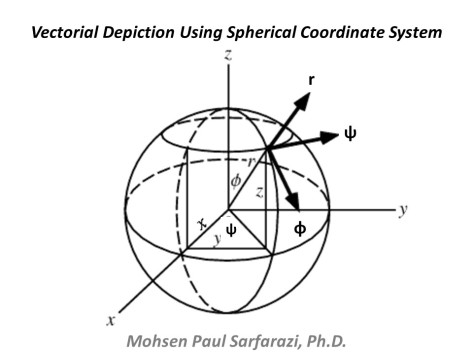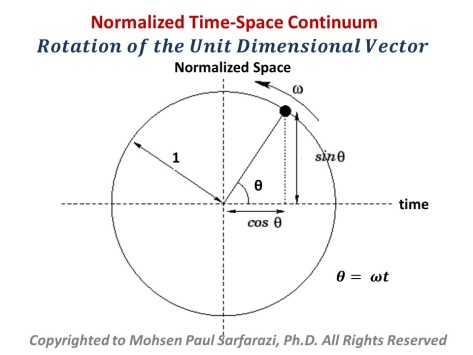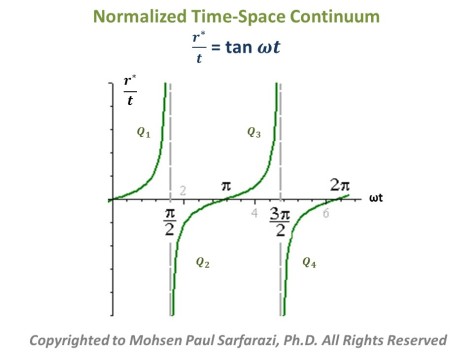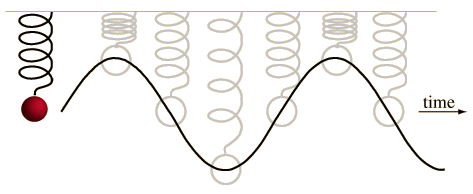Abstract
Further elaboration of time-space continuum has been presented. The graphical representation of dimensional time-space continuum originally proposed by the author has been further expounded upon. It is suggested that the time-space continuum is in a constant state of fluctuation, ever expanding and contracting in time, giving rise to a radial vibration that may be characterized by a single degree of freedom (SDOF) system. It is proposed that a particular time and space continuum may be characterized through definition of a certain ‘dimensional angle’ measured from a particular reference axis, and the collection of time and space continuums may be traced through rotation of a position vector in space at a rotational rate given by ω = θ/t, where θ and t denotes the ‘dimensional angle’ and time, respectively. An object or entity is said to resonate to or reside within a particular time and space continuum when its natural frequency of vibration equal to √k/m matches the threshold frequency of that particular dimension. Furthermore, the natural frequency of vibration of a sentient entity determines its state of consciousness. It has been proposed by the author that in the case of a sentient entity resonating to a given continuum of time and space, the parameter k indicated herein may be defined as the ‘consciousness expansibility coefficient,’ which is related to the extent of karmic energy stored within the soul. Furthermore, it has been explicated by the author that karmic energy, whether positive or negative, arises from the very radial vibrational action of the soul either contracting towards or deflecting away from the SOURCE, respectively. The planar depiction of time and space continuum previously proposed by the author has been expounded upon further. It is suggested that the planar description of the time-space continuum entails rotating a unit vector in a plane consisting of the normalized space, or the alternatively, the frequency as the ordinate, and time as the abscissa. Four separate quadrants have been identified by such a planar depiction, and it is said that only one needs to be studied as the other three are comprised of the mirror image of the same with respect to either space, time, or both coordinate measures. Each dimension has been represented by a unit vector subtending a dimensional angle in the plane and it is said that consecutive continuums of time and space may be accessed through a change in the dimensional angle by 10 , giving rise to a a maximum of 89 such distinguishable dimensions within one quadrant or 4 x 89 = 356 dimensions in all. By expressing time as a sinusoidal function of the dimensional angle thus designated, and considering the Taylor series binomial expansion of the sin function in the dimensional angle θ, it is shown that for any angles that lies within the limits 0 < θ < 50, it is seen that all the higher terms in the binomial representation of the sin function of the dimensional angle representing time may be neglected, thus implying the linearity of time within the lower dimensions. It is thus concluded that for all practical purposes time is linear within the lower dimensions than the 5th dimension. Finally, a soul might radially vibrate in more than one sub-dimensional continuum of time and space simultaneously in what is referred to as the NOW moment as segmented constituents of itself that is referred to as the ‘soul aspects.’ This way, soul consciousness is driven by a multi degree of freedom (MDOF) vibrating system that is referred to as ‘multidimensional vibration.’ Thus. multidimensionality is synonymous with vibrating as a multi degree of freedom (MDOF) system.
Introduction
- A graphical model for depiction of the dimensional time-space continuum has been proposed by the author previously [1-2].
- It was said that a dimensional time and space continuum necessitates the specification of a position vector r to characterize space and another measure defining time.
- The position vector r defines space in a static, non-changing sense.
- If cosmos were static and non-changing, we would only have to specify r to describe it.
- The cosmos is, however, dynamic, ever changing, ever evolving.
- And, dynamism necessitates the specification of another measure – that of time.
- Note that the cosmos was created by the Prime creator imploding upon itself from a singular point in order to create the space.

- And, it is true that to characterize space we only need to specify a vectorial quantity, the position vector measured from the point of origin, or appropriately, 3 distinct scalars, each depicting a coordinate of the object or entity in the space, namely, the length (or width), breadth, and height (or depth).
- As it will become more clear, it is actually more pertinent to use a spherical coordinate system to describe the position vector stretching from the point of origin to an end point, which may be defined through specification of 3 scalars: the length of the radius of the position vector r, and two angles that the projection of the position vector on the horizontal plane xy makes with say the x axis, denoted by say, ψ, and the projection of the position vector on the transversal (vertical) plane yz that makes with say the z axis, denoted as φ.
- This is illustrated in the slide below.

- But to characterize a ‘dimension,’ we also need to specify the ‘time’ measure.
- Note the distinction between ‘dimension’ and ‘measure’ made here, avoiding the general misconception that each coordinate specified to characterize the third dimension (3-D) are, in essence, each a ‘measure’ (say length/width, breadths, and height/depth) and not a ‘dimension!’
- Time is what gives the cosmos its dynamic nature.
- If we assume that the dimensional layers of cosmos can only contract or expand, then the time measure can be specified as a single scalar number (either positive or negative) that would depict either the ‘expansion’ or ‘contraction’ of the position vector r in the cosmos.
- Arbitrarily chosen, respectively, the positive number insinuates contraction, and a negative number, the deflection or expansion of space within the dimensional time and space.
- As the measure of time is assumed to be a scalar parameter that varies along the radial position vector defining the space, time is perpendicular to the surface of the spherical domain defining space.
- And, as we vary time to and fro the radial vector of space, we create layers within the cosmos that each define a particular dimension of time and space.
- So, to summarize:
- 1. The position vector r defines the static space.
- 2. A scalar parameter is assumed to depict time having the well-defined direction given by the unit vector n = r/r.
- 3. And, the normalized quantity r/t defines a particular dimension or time-space continuum.
- Therefore, a dimensional time-space continuum arises from the expansion or contraction of the space vector r in time t.
- In this respect, a dimensional time-space continuum is envisioned to be ever in radial vibration.
- And, of course, any object or entity that lies within such a time-space continuum is envisaged to vibrate rectilinearly and radially within it.
- Each dimension can be characterized by a dimensional angle θ defined from a reference axis.
- Alternatively, each dimensional time-space continuum can be described by the rotational speed θ/t = ω, which is referred to as the ‘frequency.’
- If the dimensional angel θ is measured in radians and time in seconds, then the frequency ω is measured in the units of radians per second (rad/s), which is alternatively, attributed to Hertz, and is denoted as Hz.
- Note that each dimensional layer from the next or previous one is defined by a unit change in time.
- In fact, each dimensional layer has a certain threshold energy associated with it that needs to be expended to traverse that dimensional layer.
- The author has proposed that there are 356 such dimensional layers definable in the cosmos.
- Between each spherical boundary there is a repulsive field that needs to be overcome before entering that dimensional layer.
- This energetic is characterized through specification of a ‘threshold frequency’ denoted as ω.
- And, this is quite appropriate because frequency is related to the inverse of time and it is time that epitomizes a particular dimension.
- It has been elaborated by the author that any object or entity has an inherent parameter of state known as the natural frequency of vibration.
- And, according to the law of frequencial resonance, it begins to vibrate ‘naturally’ and ‘freely’ within a given dimension of time and space when its natural frequency of vibration matches the threshold frequency of that particular dimension.
- In terms of vibrational response we can write:
ω = 2π /T
- Where T is the time taken for a whole cycle of vibration or oscillation within a time-space continuum.
- Note that one enters a dimensional time and space when one’s natural frequency of vibration is matched with the threshold frequency for that particular dimension.
- And, the term ‘free vibration’ explicates the condition that no outside forces are involved to drive an entity or an object to be set in motion other than its own natural frequency.
- THE ‘LAW OF FREQUENTIAL RESONANCE’ INDICATES THAT WHEN THE NATURAL FREQUENCY OF TWO OBJECTS/ENTITIES MATCH, BOTH ENTITIES BEGIN TO VIBRATE ‘NATURALLY’ AND ‘FREELY’ AND SYNCHRONOUSLY AND HARMONIOUSLY TOGETHER [3].
- So, in essence, space is not static.
- It oscillates back and forth or to and fro through time, ever expanding and contracting.
- And, with its oscillations also vibrates each and every entity or object that lies within it.
- The vibrating space in time is what we call a dimension or a time-space continuum.
- The oscillations of the space is procured through light with frequencies that expand much beyond those of the visible light [4].
- And, those that have sentient consciousness resonate with the vibrational frequencies of light.
- A conscious being has the capability of being aware of the time and space and does not just get set in motion like an object.
- It begins to interact with the time and space it resides within.
- And, as its consciousness grows, it becomes privy to traverse higher dimensions of consciousness, and look within or inside lower dimensions of time and space.
- THE ‘LAW OF DIMENSIONAL CONSCIOUSNESS SHIFT’ INDICATES THAT A HIGHER DIMENSIONAL ENTITY CAN ‘SEE THROUGH’ THE LOWER DIMENSIONS BUT THE OPPOSITE IS NOT TRUE, THAT IS, HIGHER DIMENSIONS ARE STEALTH TO THE LOWER DIMENSIONAL BEINGS [3].
- And, when the frequency of an entity expands, it has the capability to traverse and manipulate other continuums of time and space.
- The uplift in frequency is achieved through experimentation and learning.
- Note that the degree of consciousness determines how a sentient being perceives time and space.
- For example, in the lower dimensions (below 5th) one perceives the progression of time to be linear, with a clear past, present and future in sight.
- However, all the holographic programs of time and space run simultaneously together.
- Strictly speaking, there is no past, present, or future, and it all happens in the NOW moment concurrently.
- It is up to an observer to resonate with a particular continuum of time and space to be privy to participate in that dimension.
- Without light all vibrations, as we refer to as ‘life,’ seize to exist.
- A soul vibrates in antimatter.
- An incarnate is of matter that gains sentient consciousness through infusion of the antimatter of a soul aspect with its matter.
- In this respect, the mass element is composed of the physical bodily matter as well as the antimatter constitution of the soul.
- Although it takes much effort and energy as may be characterized by an uplift in frequency to traverse a higher dimension, there also exists sub-layers between two consecutive dimensional time-space continuums.
- For example, there are 7 different sub-layers between the 3rd and the 5th dimensions.
- These include the Ethereal, Astral, Emotional, Thought, Causal, Spiritual, and Crystalline sub-layers, and the latter 6 sub-layers residing in the 4th dimension.
- And, the Ethereal sub-layer lies between the 3rd and the 4th, which constitutes the energetic boundary layer between the two dimensions.
- Furthermore, within one particular dimension of time and space, say the 3rd, one can define a series of ‘parallel’ dimensions with time and space continuums running parallel at threshold frequencies that are very close to one another.
- These parallel dimensions are part of holographic software programs that define myriad of matrices of time and space with details of life sojourns that are only slightly different from one to the other.
- They are the realms in which a soul fragments itself to form soul aspects that would experience different life sojourns distinct from one another in small details in order to uplift its overall spiritual educational practice.
- On the other hand, a soul may join other souls to form an ‘oversoul’ to take up a a larger role in the cosmos by overseeing the affairs of such bigger conscious groups incarnating at a much greater scales that may include a planet, or even a planetary system.
- And, in turn, oversouls may congregate to form a higher conscious unit known as an ‘avatar’ responsible for guidance or control of a much more gigantic planetary or solar system.
- Even avatars may connect to form a non-corporeal form called ‘rishi.’
- Above the level of rishi, these immense conscious units may even link to form higher conscious forms, the details of which is beyond the scope of this manuscript.
The Planar Depiction of Time and Space
- The author has proposed a simple planar depiction of time and space continuum [1-2].
- In this illustration, which represents a ‘normalized’ aspect of space-time continuum, a dimensional time and space is characterized by a unit vector rotating at a rate of θ = ωt in a planar field consisting of time as abscissa and a measure of space such as normalized space or frequency as the ordinate.
- At any time in its history, the unit vector subtends an angle θ = ωt with a reference axis, which is chosen as the abscissa or the time axis, herein.
- In the planar depiction of time and space as elucidated earlier, the dimensional number thus designated, varies from 1 to 356 as a proper integer, describing individually identifiable dimensions.
- And, each dimension has an associated energetic barrier that needs to be crossed through matching the frequency of vibration that is definable by such dimensional angles.
- Thus, in this planar model, each interval of the dimensional angle defining the next consecutive dimensional designation is apart from its former dimension by 10.
- And, this designation is obviously appropriate because in order to visualize or graphically depict time and space continuum we are, in essence, also normalizing the measure of time.
- By marching time through advancing (or retreating) a ‘unit’ at a time, this leads to consecutive dimensional angles being apart at an intervals of 10 at the time, with each depicting a particular dimension.
- And, once this is accomplished, one can identify 89 distinct divisions of dimensional angles within each of the 4 possible quadrants, with each representing a single continuum of time and space.
- The diagram below illustrates the rotation of the unit vector, as a unit radius of a circle that depicts the particular time and space continuum.

- At any given dimension one can write:
t = cos θ
r* = sin θ
- Where t denotes time and r* the normalized space.
- Clearly:
r* = t . tan θ
- Rewriting this:
r*/t = tan ωt
- Plotting the above equation in time:

- Note than tan θ denotes the slope or the gradient that defines every dimension of time and space in the cosmos.
- Therefore, physically speaking, in order to change dimensions one must ‘glide’ or ‘slide’ on a gradient defined by the slope of the dimensional angle, or simply must change slope.
- This plot shows the asymptotic nature of the normalized time-space continuum, with the domain between each asymptotic axis at 0, π/2, 3π/2, and 2π angles of dimensional angles respectively, representing a particular quadrant.
- It was said that 4 distinct quadrants can be identified within the planar depiction of time and space, but one needs to concentrate on only one at a time, say the 1st quadrant (Q1), as the other three (Q2, Q3, Q4) are mirror images of the former with respect to space (Q2), time axes (Q4), or both (Q3).
The Inter-relation of Vibration and Time-Space
- In this manuscript, attempts will be made to expound on the previous graphical model of time-space continuum furthermore, presenting additional details that explore the interrelation between vibration profile and time-space continuum.
- The author has devised a simple model in which dimensional space-time can be envisioned in a planar plot using time t as abscissa and a measure of space such as the radial vibrational profile r as the ordinate.
- It was said that the dimensional space-time could be represented as a unit vector making a ‘dimensional angle’ with a reference axis such as the abscissa (time axis).
- And, it is this dimensional angle that designates the particular dimension thus described in the cosmos.
- Furthermore, the dimensional angle carries with it the characteristic that distinguishes the continuum space from the dimensional time-space, which is none but the measure of time itself.
- Note that the measure of time is considered as a single scalar because it is found from either expansion or contraction of the position vector.
- Thus, it can be specified through a single scalar number that nevertheless does have a sense (negative or positive) but a known direction as specified by the position vector (along the radius of the sphere).
- Therefore, we can define ‘frequency’ as the ratio of the dimensional angle and the time measure:
ω = θ/t
- Or:
θ = ωt
- Where θ = ωt is the dimensional angle, which is measured in either degrees varying between 0 and 360, or radians changing from 0 to 2π.
- Thus, the units of the frequency ω can be specified as radians per second, which is referred to as Hertz denoted as Hz.
- Note that in previous publications the dimensional angle was measured from the space axis and thus the vibration profile was found to be a cosine function of ωt [5-7].
- To match the vibration profile to the diagram depicting space-time, i.e., from the t axis (π/2) from the earlier configuration, we must write:
r = r0 sin (ωt)
- This vibrational profile is shown below:



- The above slide indicates the rotational unit vector of normalized time-space continuum as it subtends the domain of all possible dimensional time-space continuums.
- Furthermore, it demonstrates how the rotation of the unit vector of time and space continuum correlates with the radial vibrational profile of an object or entity within a particular dimension.
- In essence, this diagram illustrates that an object or entity resonating within a particular dimension of time and space undergoes a single degree of freedom (SDOF) radial vibration.
- And, this is intuitively correct as when a dimensional layer is considered to expands and contract radially only, thus vibrating rectilinearly in time, an object or entity undergoes a single degree of freedom vibration.
- When considering a SDOF system, the entire constitution of an entity/object is perceived to be as being concentrated at a single point.
- For a SDOF vibration:
r/r0 = sin ωt
t = cos ωt
- Thus:
(cos ωt)2 + (sin ωt)2 = 1
- The above equation gives the ‘orthogonality condition.’
- Considering a ‘normalized’ space-time continuum where a unit vector rotating in the 2-D plane with an angle ωt depicting the dimensional phase angle we can write:
(r/r0)2 + t2 = 1
- Where (r/r0) denotes normalized space.
- Thus, the above relation confirms that time and space are, indeed, related to one another through an orthogonality condition that indicates that they are perpendicular to one another.
- In other words, it states that the role of time is to expand or contract the space, represented by a spherical domain, in the direction that is normal (perpendicular) to the surface of the spherical sphere (i.e., along the radius of the sphere).
- Rewriting the above equation:
t = √[1-(r/r0)2]
- This equation shows that when the normalized space is increased, time decreases and vice versa.
- Thus, not only time and space are related to one another, one acts inversely to the other.
- Time and space form a conjugate pair defining the behavior within a dimensional continuum.
- Also, if you write the function cos ωt and sin ωt as binomial series using the Taylor expansion:
cos ωt = 1 – (cos ωt)2/2! + (cos ωt)4/4! – (cos ωt)6/6! +….(cos ωt)n/n!
sin ωt = ωt – (sin ωt)3/3! + (sin ωt)5/5! – (sin ωt)7/7! +….(sin ωt)n/n!
- With cos ωt being an even and sin ωt an odd function of ωt.
- Also when 00 <ωt< 50 degrees, the higher order terms than linear can be neglected, i.e.,
cos ωt ≈1 and sin ωt ≈ ωt
- Here, it is said that time is ‘linearized.’
- This means that up to the 5th dimension time is linear.
- Note that a soul might vibrate in more than one continuum of time and space simultaneously in what is referred to as the NOW moment as segmented constituents of itself that is referred to as the ‘soul aspects.’
- This way, soul consciousness is driven by a multi degree of freedom (MDOF) vibrating system that is referred to as ‘multidimensional vibration.’
- Thus. multidimensionality is synonymous with vibrating as a multi degree of freedom (MDOF) system.
Institute Of Spiritual Science Inc. Publishing 2016
All Rights Reserved.
No part of this article may be fragmented or copied without a written approval by the author.
This article may be shared or posted on websites, Facebook pages or any public forum only in its entirety, and only if it is offered free of charge to the public without any page charges, download fees, or membership charges.
References
- Mohsen Paul Sarfarazi, Ph.D., Dimensions of Consciousness Multidimensional Consciousness, wordpress.com
- Mohsen Paul Sarfarazi, Ph.D., A Model for the Graphical Depiction of Dimensional Time Space Continuum Quantum Micro Mechanics of Cosmos, wordpress.com
- Mohsen Paul Sarfarazi, Ph.D., Fundamental Laws of Cosmos Inter-relating Consciousness Constitution [Matter – Antimatter] and Energy Quantum Micro Mechanics of Cosmos, wordpress.com
- Mohsen Paul Sarfarazi, Ph.D., The Effect of Cosmic Radiation and Ionization on Earth Humanity Ascension Quantum Micro Mechanics of Cosmos, wordpress.com
- Mohsen Paul Sarfarazi, Ph.D., A Mathematical Model for the Quantification of Consciousness [Soul Animation] Multidimensional Consciousness, wordpress.com
- Mohsen Paul Sarfarazi,, Ph.D., A Mathematical Model for the Physical Vibration [Animation] of an Ageing Sentient Body Quantum Micro Mechanics of Cosmos, wordpress.com
- Mohsen Paul Sarfarazi,, Ph.D., Mathematical Models for Vibration of Multiple Mutually-Aware Soul-Aspects: Soul Aspects Vibrating as a SDOF Ensemble Quantum Micro Mechanics of Cosmos, wordpress.com